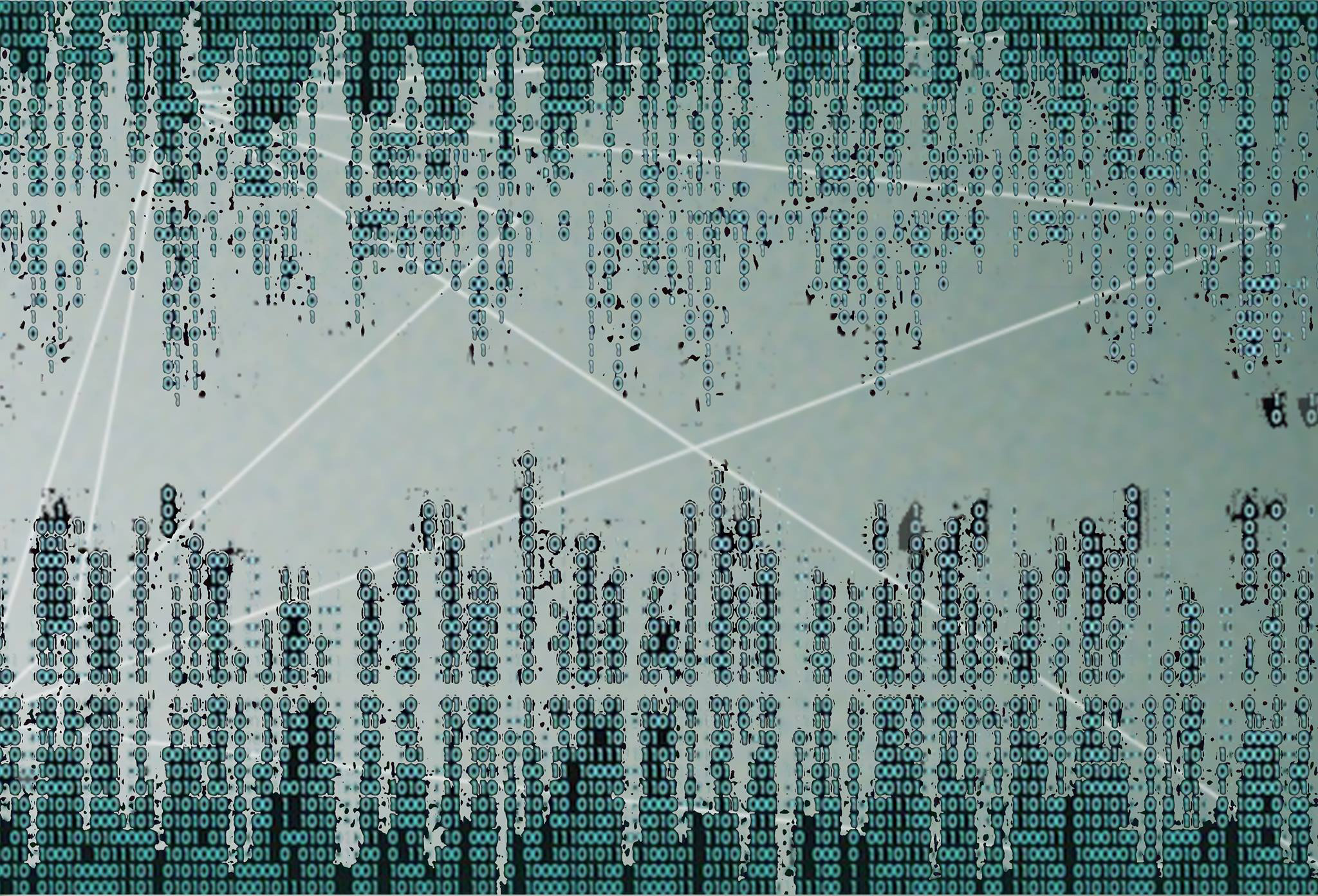
NODES_X
Byrke Lou
nodes_x is a new media art performance about private data flow in the world wide web.
While we are surfing, searching and sharing we pass data to a number of institutions, companies and individual players.
Every player in this complex system can be represented by a node. Every exchange with a node increases the data that is publicly available about us.
nodes_x consists of live coded music, coded visuals and performance elements.
Byrke Lou grew up in the Berlin clubbing world. She studied physics, philosophy, electro acoustic composition and Digital Media and worked in complex systems research institutes across europe. She travelled South America, West Africa, Europe and the Middle East, presented her work at Ars Electronica, Transmediale and CTM Berlin. She educated and mentored young women on creative business, coding, diy electronics and electrodynamics privately and at universities. Throughout she never gave up her love for dancing and the clubbing scene. Byrke’s artistic work examines why we produce new technologies and how these technologie’s data shapes our perception.
byrkelou.comVLOG #1: CALLUMS WERLD! WERK!!!
Callum Harper
You can be famous if you try, just get a smartphone. YouTube. Instagram. Facebook. Grindr. Have you ever heard of these? Find your niche! As an internet celebrity, we can all be relatable, and give the best advice from REAL life experiences.
I can’t possibly ask my mum or dad for advice about a girlfriend, I have to turn to the internet, where other lonely people who accentuate their quirkiness and relatable personalities will help me out! Ugh, vlogging, am I right? We love it, but why? Oh that’s right, as awkward people we turn to the internet to seek something familiar, but that’s just a case study on myself. The world is forever changing, the melding of IRL and URL has become synonymous with mixing the wet and dry ingredients together as in a cake recipe. Which could be translatable to a methodology for life, wet and dry, good and bad, online, augmented, fictitious personas and real life transparent, confused souls. Is it superficial though? Join me, in Callum’s World. Werk! I’ll teach you how to live correctly. I’ll tell you the hottest tips in fashion, hygiene, sport, well being, music, make up, professionalism and much, much more! The world is forever changing, technology has grasped our everyday lives. A necessity to some, convenience for others, and an advice forum for all. Google: symptoms; YouTube: life lessons; Instagram: Memes; Facebook: connecting with our friends that we never speak to in reality. This anecdotal, satirical Vlog comments on the ideals of self comportment, the fluidity of identification IRL vs. URL, as well as the notion that in 2017, we trust and find comfort in the voice of strangers with more followers than morals online, compared to our IRL counterparts. This Vlog-teaser uses commercial and marketing appeal of humour, to draw the viewer in with the domesticated background of a home balcony for unconventional and uncertain creature comforts. Welcome home, to my world, as I say it, and how you should live yours, as YouTube’s terms and conditions might say if any Vlogger ever read them.Born in Australia now based in Glasgow, Callum works with notions around LGBT culture, and combines discourse around reality and online life to create dialogue around the disparate differences of communication IRL vs URL. Primarily working with text, video and performance, Harper travels to varied destinations of contrasting political values toward LGBT citizens, and internalises locals opinions and his personal experiences on acceptance and daily life. The amalgamation of this collected experiential information and research data informs the medium and personal responses to experiences within differing contexts. Harper holds a Bachelor of Fine Arts from Monash University in Caulfield, Australia, and a Master of Fine Arts from Konstfack in Stockholm, Sweden.
callumharper.squarespace.comvimeo.com/callumharper
A LIFESTYLEGUIDE TO BETTERING YOURSELF TOWARDS YOUR IMMINENT FUTURE AS OMNIPRESENT INTERNET ENTITY™
Esben Holk
HOUSE OF KILLING feat Esben Holk presents the life-altering home-improvement video package: a lifestyle-guide to bettering yourself towards your imminent future as omnipresent internet entity™ ! 2017. A complete necessity for any digital and anatomical body embarking on their transition into ontological uncertainty through internet stardom! Get your body ready for all the likes and shares coming your way!
Famous from such videos like “#BEMOREPOSTHUMAN” and “how to find your Cyberspace Sadness™”, Esben Holk introduces this 3 step plan for bettering yourself towards your imminent future as omnipresent entity! Now including never before seen advice on how to deal with the notional and material consequences of your new position as recognised item. watch it today!u r better for wanting to better yourself!
good job
xoxo
HOUSE OF KILLING feat Esben Holk is a BFA graduate from the Bergen Academy of Art and Design 2017, with a background in creative coding, browserbased experiences and performative strategies. Concerned with the absence of ontological density in the material and notional existence of produced entities, such as the queer, he has been researching the agility of the proposed borders that define such objects. Vehemently anti-essentialist and anti-naturalist, the posthuman artist proactively approaches the sensation of being a lost entity as a weapon in a revolution. Almost like a selfcomforting mechanism, the works are desperate attempts to find meaning and reason with the constant displacement from certainty: an unsubstantiated self, in selfharming ways, trying to find substance.
houseofkilling.netFLY HIGH OR I FLY ABOVE YOU
Paul Wiersbinski
By aggregating from one state to the next, information does not only change form but meaning. Random packages of bytes drive by and leave the odor of shitstorms. Zones of hyper focus and depression fade into each other to create the constant flow of newsfeed streams. Quotes from interviews with plastic surgeons and celebrity porn stars are recited on digital gravestones.
Every translation creates a mirror, which reflects and vaporizes the initial purpose. There are now two half-real worlds, which consume, digest and spit out each other in a never ending feedback loop. It is the mixed and merged fantasie of monsters, machines, plants and human beings filling the incompleteness of the real world with their imagination.
Paul Wiersbinski studied video art with Mark Leckey and Douglas Gordon at the Städelschule in Frankfurt (Main) and currently lives and works in Berlin. The result of his artistic process is presented in multiple forms and mediums, often taking the shape of complex sets and installations, which have been presented internationally.
Text: Lieve Matthessen

TRUST-BASED, PRE-PUBERTAL, AND MILD-MANNERED.
Internet celebrities and network falsification.
Philipp Teister
“FAMOUS for dayzzzz” is Philipp Teisters’ new work and contribution for the Internet and Fame pavilion of the Wrong biennial in 2018. Using a piece of furniture which is normally found in the living room and being used primarily for seating, he found a unique object of euphemism affirmative action.
“FAMOUS for dayzzzz” more than a regular and multiple-charged with various meanings over one century. Teister’s title for his new work holds a hint to what the artists is trying to endeavor when showing this rather simple object in the context of an art exhibition which deals with The Internet and The Fame most of us nowadays are living up to or reaching out for.
His work latest work includes even a larger repertoire of theories, from socio-biological to techno-societial—presenting an off-line property developed by online memes and its characteristics of the social world that surrounds us in our daily life in the Digital Age.
“ 't Must be said, one couch to burn is better than
surfing” – Oscar Wilde
Like demanding sexual favors, subordinate to a superior in return for entry into occupation, Teisters’ work deals with and ask the right questions with specific reference to Internet, Fame and a passé euphemism which normalizes sexual harassment and sexual assault.
Philipp Teister is an artist working with Internet technology and
its impact on human history. Revealing the aesthetics of
appropriation and conceptualism, he uses overriding strategies and
intensively challenges the transitional area between privacy and
anonymity. As a visual artist Teister seeks to overcome the
separation of these forms and genres of art by trying to endeavor a
holistic artistic approach.
Philipp Teister, born 1982, lives and works in Vienna/AT. He holds a
MFA in New Media with honors from School of Arts and Design in
Kassel/Germany. From 2009–2012 he has been committed in a
cooperation and projects together with the artist duo
UBERMORGEN.COM. He lectured at UT Vienna, ETH Zurich and BTH
Cottbus. His work was shown in WRO Bienale in Wroclaw,
Kuenstlerhaus in Vienna, NIMK in Amsterdam, and Palais de Tokyo in
Paris. He is represented by Fach and Asendorf Gallery in
Berlin/Bremen. His favorite animal is the horse. And Only god Knows.
PORTRAIT 7: WARHOL
Roberto Voorbij
One could say that Warhol's prophecy regarding 15 minutes of fame has largely become true. With the expansion of the internet to a platform where any user can broadcast its very own channel, his promise has been more than fulfilled. The repeating of fame which initially creates fame and subsequently flattens and destroys it, has increased as well. 'Portrait 7: Warhol' presents the artist as a work of art, the performer, the public personality. Warhol himself is transformed into a product, a brand, a media phenomena. He puts on the face of a celebrity. Warhol himself replaced with images of violence. Everything in high speed, shorter than a quote, reduced to a cry, a signal, a pulse. Dadaist and surrealist. Pop art itself as the subject. Popular art derailed. Popular art or the art of popularity?
Roberto Voorbij (1974) lives and works in Amsterdam, holds a bachelor degree in Visual arts and Art History from the Utrecht School of Arts and has attended the School of the Art Institute of Chicago. Voorbij is a interdisciplinary artist, besides working with ‘ready made’ materials, he works with 3D Software, video and (digital) collage.
robertovoorbij.com